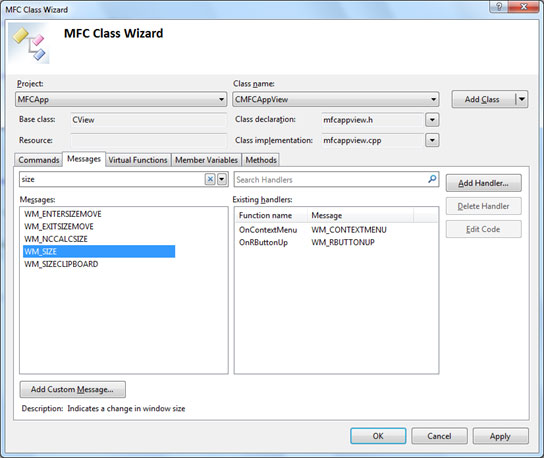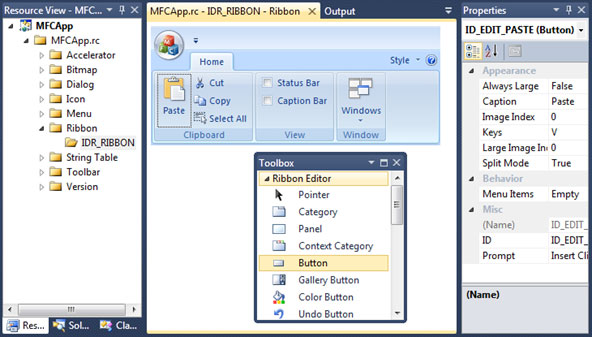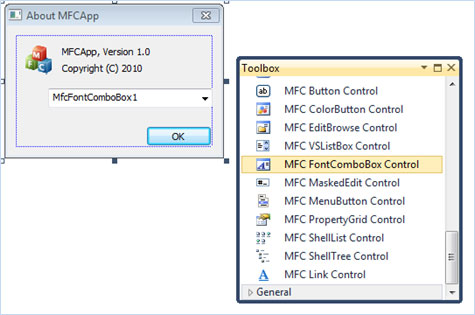MFC Class Wizard. We implemented a well-known for Visual C++ 6.0
developers Class Wizard tool. This addition provides developers with an easy
way to maintain a class context inside one box: you can assign a command
handler to the object ID, add a message handler, override a virtual function
and add class members and methods. Each list control such as commands or
message list comes with a corresponding filter box, so you can quickly
locate a required name among hundreds names.

Hit Ctrl+Shift+X and see how easy is to maintain your MFC application now!
-
MFC Ribbon Designer. Visual Studio 2010 introduces an easy way to
edit the Ribbon control: this designer dramatically simplifies the ribbon
creation process and allows creating the "state of the art" products in few
minutes! You don't need to write hundreds lines of code anymore: just open
the Ribbon Designer in the Resource View and enjoy using it. You can drag
the Ribbon elements like buttons or galleries from the Visual Studio toolbox
and drop them to the ribbon editor, assign high-color images to the ribbon
buttons, preview your ribbon in various visual themes such as Office 2007 or
Windows 7 and add MFC command handlers directly from the designer. The
properties of the selected element can be edited in the Visual Studio
"Properties" pane.

After you've finished designing the Ribbon layout and appearance, you need
to add just a single line of code to load the Ribbon from the resources:
m_wndRibbonBar.LoadFromResource(IDR_RIBBON);
Auto-Complete for #Include statement. This feature enhances
Visual C++ editor IntelliSense. Now, when you begin typing a file name after
'#include' statement, a popup list with matching file/folder names appears.
The tooltip on the right of file name shows the full file path.

New MFC controls in the Dialog Editor. The rich set of the new
MFC controls introduced in Visual Studio 2008 Feature Pack appears now
inside Visual Studio Toolbox. You can drag the new control from the toolbox
to the dialog and modify its properties in the "Properties" pane.

Dialog Editor Mockup Background Image. Sometimes you need to
create the dialog layout from mockup images prepared by a graphic artist or
application GUI designer. In Visual Studio 2010 Dialog Editor you can load
an external image and put in on the dialog working area. Now just drag the
dialog controls and move them to the required location according to the
predefined layout. The new "Mockup Image" dialog bar located at the bottom
of the Dialog Editor allows specifying image path, transparency and
offsetting.

Windows 7 Taskbar Interaction. An MDI application now
automatically takes advantage of interaction with Windows 7 taskbar. You
don't need to write any additional code to have a view content displayed on
taskbar thumbnails, or pick a view by hovering over thumbnails and clicking
them.

Windows 7 Ribbon Theme. Visual Studio 2010 introduces new visual
manager 'CMFCVisualManagerWindows7'. You can use the following code for
enabling Windows 7-like application/ribbon look:
CMFCVisualManager::SetDefaultManager(
RUNTIME_CLASS(CMFCVisualManagerWindows7));
m_wndRibbonBar.SetWindows7Look(TRUE);

- Windows Explorer Interaction. In Visual Studio 2010 an MFC
document can interact with the Windows Explorer. The following functionality
has been implemented:
- Document icon displays the latest saved content.
- You can preview the document in Explorer "Preview" and "Details"
panes.
- Document search.

High DPI support. MFC is High DPI-compatible now: you can run
your application in High DPI modes without any visual artifacts. All
toolbar/menu/ribbon images will be scaled automatically using a smooth
resizing algorithm. In addition, you can load a special image set prepared
for the specific screen resolution.
Windows Touch support. CWnd class has a new set of Touch/Gesture
message wrappers and you can add Windows Touch support to your application
in few lines of code.
Transactional File System support. A new CAtlTransactionManager
class provides a wrapper to Kernel Transaction Manager (KTM) functions. You
can either use this class as standalone object or along with existing MFC
file management classes such as CFile.
Common File Dialog update. Implemented new Windows Vista/7
features such as custom fields, properties and favorite places in
CFileDialog class.